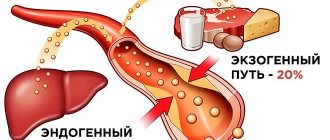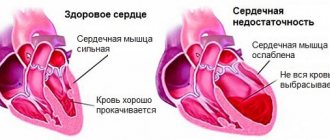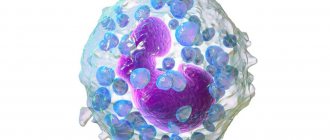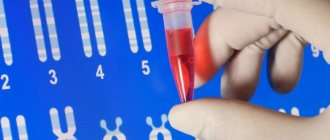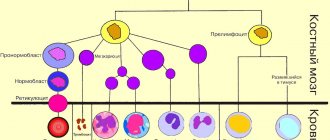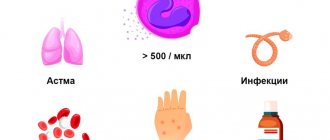Triglycerides
Triglycerides are fats, one of the main sources of energy for body cells. Increasing their levels increases the risk of heart and vascular disease, as well as the risk of developing acute pancreatitis.
Research method
Colorimetric photometric method.
Units
mmol/l (millimoles per liter).
What biomaterial can be used for research?
Venous blood.
How to properly prepare for research?
- Do not eat for 12 hours before the test.
- Avoid physical and emotional stress and do not smoke 30 minutes before donating blood.
General information about the study
Most triglycerides are found in adipose tissue, but some are found in the blood, providing energy to muscles. After eating, triglyceride levels rise as the body converts energy that is not needed into fat. Triglycerides are absorbed in the intestines and, transported through the blood, are stored in adipose tissue as reserves. Between meals they are burned, releasing energy for the body.
Because triglycerides are insoluble in water, they are carried in the blood with a protein in the form of a complex called lipoprotein. There are several types of lipoproteins, differing in the proportions of their constituent components:
- very low density lipoproteins (VLDL),
- low density lipoproteins (LDL),
- high density lipoproteins (HDL).
Most triglycerides in the body are carried by very low-density lipoproteins (VLDL).
An increase in triglycerides increases the risk of developing cardiovascular diseases, although their causes are not fully understood.
There are a number of factors contributing to this: decreased physical activity, excess body weight, smoking, alcohol abuse, and diabetes.
In addition, triglycerides significantly increase the risk of developing acute inflammation of the pancreas - acute pancreatitis.
What is the research used for?
- To assess the risk of developing atherosclerosis and problems with the heart and blood vessels.
- To monitor the effectiveness of the diet and monitor blood lipid levels after prescribing medications that lower triglycerides and cholesterol.
What do the results mean?
Reference values (normal triglycerides): 0 - 2.25 mmol/l.
Interpretation of the results should be made taking into account other tests included in the lipid profile.
The cause of increased triglyceride levels may be the result of a hereditary predisposition or excess dietary intake of animal fats.
In adults, during a preventive examination, the results are divided into several groups according to the degree of risk:
- acceptable TG level – below 1.7 mmol/l – reflects a low risk of cardiovascular diseases,
- borderline level – 1.7-2.2 mmol/l,
- a high level of triglycerides – 2.3-5.6 mmol/l – indicates a high likelihood of developing cardiovascular diseases,
- very high - above 5.6 mmol/l - in addition to the high risk of heart problems, in this case there is a very high risk of developing pancreatitis, so early administration of drugs that reduce the concentration of TG is required (optimally - to 1.3 mmol/l or lower).
Before prescribing treatment, it is necessary to exclude other causes of elevated triglycerides:
- alcoholism,
- chronic inflammation of the kidneys leading to nephrotic syndrome,
- chronic renal failure,
- decreased thyroid function (hypothyroidism),
- poorly treated diabetes mellitus,
- pancreatitis,
- myocardial infarction - in this case, elevated levels may persist for up to several months,
- gout.
Reduced triglyceride levels (hypotriglyceridemia) are not of particular clinical significance.
Why do triglycerides increase?
There are several reasons and factors under the influence of which triglycerides in the blood can be elevated. First of all, we are talking about poorly treated diabetes mellitus, a heart attack, the use of a number of medications (beta-blockers, diuretics, birth control pills) and alcoholism.
Note that excessive alcohol consumption combined with a high-fat diet causes a double blow to the body, leading to a dangerous increase in triglyceride levels. Other chronic diseases that create a risk factor include decreased thyroid function and various kidney diseases.
Fatty liver
Normally, the fat content in the human liver is about 5% - however, with fatty hepatosis, this figure can reach 50%. Excess triglycerides in the blood increases the amount of fat that penetrates the liver cell - while reducing the ability to utilize it.
Excessive amounts of fatty acids in the liver lead to the formation of highly active compounds that further damage the cell. The next stages of the disease are hepatitis (liver inflammation), development of liver failure and cirrhosis.
What are the dangers of high triglyceride levels?
With high levels of triglycerides, along with other factors such as a sedentary lifestyle and excess weight, the risk of heart disease and atherosclerosis increases.
When there are excess triglycerides circulating in the blood, they begin to accumulate in the liver, causing inflammation, which leads to non-alcoholic hepatic steatosis, known as fatty liver.
In addition, it has been found that
triglycerides above 1000 mg/dL can also cause pancreatitis.
Increasing levels of triglycerides increase levels of bad cholesterol, so the ideal solution to reduce them is to maintain a balanced diet and achieve regular physical activity.
This change, along with others such as hypercholesterolemia, contributes to the development of strokes due to arteriosclerosis (accumulation of cholesterol and fat cells in the walls of blood vessels). This plaque makes the arteries less elastic, increases blood pressure and even impedes blood flow.
Notes[edit | edit code]
- B. Martena, M. Pfeuffer, J. Schrezenmeir (2006). "Medium-chain triglycerides". International Dairy Journal 16(11): 1374–1382. doi:10.1016/j.idairyj.2006.06.015
- Jeukendrup AE, Thielen JJ, Wagenmakers AJ, Brouns F, Saris WH: Effect of medium-chain triacylglycerol and carbohydrate ingestion during exercise on substrate utilization and subsequent cycling performance. Am J Clin Nutr 1998, 67(3):397-404.
- Goedecke JH, Elmer-English R, Dennis SC, Schloss I, Noakes TD, Lambert EV: Effects of medium-chain triaclyglycerol ingested with carbohydrate on metabolism and exercise performance. Int J Sport Nutr 1999, 9(1):35-47.
- Calabrese C, Myer S, Munson S, Turet P, Birdsall TC: A cross-over study of the effect of a single oral feeding of medium chain triglyceride oil vs. canola oil on post-ingestion plasma triglyceride levels in healthy men. Altern Med Rev 1999, 4(1):23-8.
- Angus DJ, Hargreaves M, Dancey J, Febbraio MA: Effect of carbohydrate or carbohydrate plus medium-chain triglyceride ingestion on cycling time trial performance. J Appl Physiol 2000, 88(1):113-9.
- Van Zyl CG, Lambert EV, Hawley JA, Noakes TD, Dennis SC: Effects of medium-chain triglyceride ingestion on fuel metabolism and cycling performance. J Appl Physiol 1996, 80(6):2217-25.
- Misell LM, Lagomarcino ND, Schuster V, Kern M: Chronic medium-chain triacylglycerol consumption and endurance performance in trained runners. J Sports Med Phys Fitness 2001, 41(2):210-5.
- Goedecke JH, Clark VR, Noakes TD, Lambert EV: The effects of medium-chain triacylglycerol and carbohydrate ingestion on ultra-endurance exercise performance. Int J Sport Nutr Exerc Metab 2005, 15(1):15-27.
- Burke LM, Kiens B, Ivy JL: Carbohydrates and fat for training and recovery. J Sports Sci 2004, 22(1):15-30.
- Thorburn MS, Vistisen B, Thorp RM, Rockell MJ, Jeukendrup AE, Xu X, Rowlands DS: Attenuated gastric distress but no benefit to performance with adaptation to octanoate-rich esterified oils in well-trained male cyclists. J Appl Physiol 2006, 101(6):1733-43.
- Nosaka N, Suzuki Y, Nagatoishi A, Kasai M, Wu J, Taguchi M: Effect of ingestion of medium-chain triacylglycerols on moderate- and high-intensity exercise in recreational athletes. J Nutr Sci Vitaminol (Tokyo) 2009, 55(2):120-5.
What are triglycerides and what is their biological role?
Triglycerides are a type of fat found in the blood.
It is the body's largest energy reserve, allowing for mobility and availability of energy at any time, especially in conditions of starvation and food shortages.
When you exceed your intake of fats and carbohydrates, the excess calories are stored as triglycerides in the body's fat cells.
Examples of Triglyceride Lowering Products
The AHA recommends focusing on certain foods to help manage triglyceride levels. Foods that may help lower triglyceride levels include:
- Low fructose vegetables: These include leafy greens, squash, pumpkin, green beans and eggplant.
- Low fructose fruits: such as berries, kiwis and citrus fruits.
- Fiber-rich whole grains: brown rice, whole grain bread, quinoa, oats, barley and buckwheat.
- Fatty fish : salmon, herring and sardines.
- Low-fat dairy products: These include milk, yogurt and cheese.
Additionally, the AHA advises:
- limit added sugar to no more than 10% of total daily calories
- limit carbohydrate intake to 50–60% of daily calories
- keep the fat content in the diet to 25–35% of the total diet
- reduce or avoid alcohol intake
Normal triglyceride levels in men and women
The body requires certain triglycerides to be present in the bloodstream. Blood tests are commonly used to determine triglyceride levels in the body, and multiple tests may be needed to confirm accurate results.
Triglycerides are measured in mmol/L. Normal, increased and decreased values can be found in the table:
In children, the normal level is calculated using a different formula.
Important!
Low triglyceride levels occur due to diseases of the thyroid gland, gastrointestinal tract and lungs.
Other Triglyceride Lowering Options
In addition to dietary changes, your doctor may also recommend the following to lower triglyceride levels:
- Physical Activity: The AHA recommends at least 30 minutes of moderate-intensity physical activity at least 5 days per week for a total of at least 150 minutes per week.
- Achieving a moderate weight: According to the AHA, losing 5 to 10% weight results in a 20% reduction in triglyceride levels.
- Taking omega-3 fatty acids : Research suggests that omega-3s may prevent and treat hypertriglyceridemia.
- Taking niacin: Studies have shown that niacin, also known as niacin, may help lower triglyceride levels.
- Taking fibrates: Evidence also suggests that fibrates are effective in lowering triglyceride levels.
Lipoproteins
Since cholesterol is insoluble in water, it is not able to “travel” throughout the body on its own. Its transport between organs and tissues is carried out by lipoproteins.
Lipoproteins are a complex of fatty acids and other lipids with proteins albumin or blood serum globulins
. Four types of these complex protein-lipid compounds can be found in the blood, but the most significant indicators of the lipid profile are high-density lipoproteins (HDL) and low-density lipoproteins (LDL), which in the popular literature are called “good” and “bad” cholesterol.
⦁ HDL - high-density lipoproteins (“good” cholesterol).
The main function of HDL is the transport of cholesterol from the cells of peripheral organs, blood vessels, and lymphatic vessels to the liver, where it is transformed into cholic acids and excreted from the body. HDL removes excess cholesterol from the body, thereby preventing the formation of atherosclerotic plaques in blood vessels. In this regard, a sufficient level of the indicator is considered as a factor that reduces the likelihood of atherosclerosis and heart pathologies.
Reference values of the indicator are 0.91-1.56 mmol/l. When assessing the likelihood of developing cardiovascular disease, a value of > 1.0 mmol/L in men and > 1.2 mmol/L in women indicates a low risk.
⦁ LDL - low-density lipoproteins (“bad” cholesterol).
Complex proteins that are the main carriers of cholesterol into tissues. It is LDL that delivers endogenous and exogenous cholesterol to the cells of organs and tissues, and elevated levels of these substances cause the formation of atherosclerotic plaques in blood vessels. In this regard, a high concentration of LDL in the blood is a more reliable marker of the development of atherosclerosis, myocardial infarction, and stroke than an increased level of total cholesterol in the blood. Reference values of the indicator are 0-4.12 mmol/l.
Features of hypertriglyceridemia in men
The level of triglycerides in men increases with age. Due to the higher content of cholesterol and TG, men more often than women suffer from early coronary heart disease, brain disease, strokes, and myocardial infarction.
Elevated triglycerides in men of all ages are most often a consequence of poor nutrition and bad habits. Other common causes are diabetes, previous myocardial infarction, and kidney disease. Older men with gout have high TG levels.

